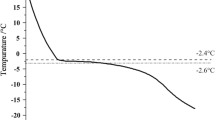Abstract
Freshness of hake stored in ice was evaluated by sensory and instrumental means. The European Union scheme and the quality index method (QIM) were used to sensorially index freshness. Aroma extract dilution analysis (AEDA) and SPME-headspace determinations were applied to monitor important odorants of hake at different freshness stages. Based on AEDA, potent odorants of hake in the very fresh state were (Z)-1,5-octadien-3-one and 3 unknown volatiles. Attempts were made to relate overall odor changes to individual volatiles: after 2 days storage, the higher FD-factors found for trans-4,5-epoxy-(E)-2-decenal, (Z)-4-heptenal, methional, and 2-acetyl-1-pyrroline were associated with the “masking” of the seaweed character, whereas the higher concentrations of (Z)-1,5-octadien-3-one and (Z)-4-heptenal in hake that reached the B grade were likely responsible for the pungent odor. No highly volatile odorants were detected in hake using SPME-headspace analysis, but in contrast to AEDA, the odor intensity of some volatiles, e.g., (E,Z)-2,6-nonadienal and 3-methylnonane-2,4-dione indicated a higher contribution. The detection of two low boiling odorants associated with fresh fish flavor is reported for the first time.
Similar content being viewed by others
References
Anonymous (2001) Eurofish 6:55–59
Luten JB, Martinsdottir E (1997) In: International institute of refrigeration (ed) Methods to determine the freshness of fish in research and industry, proceedings of the final meeting of the concerted action “evaluation of fish freshness” AIR3CT942283; Nantes Conference, Paris, France, pp 287–296
Ruiz-Capillas C, Morales J, Moral A (2001) J Sci Food Agric 81:551–558
Baixas-Nogueras S, Bover-Cid S, Vidal-Carou MC, Veciana-Nogués MT, Marine-Font A (2001) J Agric Food Chem 49:1681–1686
Ruiz-Capillas C, Moral A (2001) J Food Sci 66(7):1030–1032
Medina I, Aubourg S, Gallardo JM (2000) Eur Food Res Technol 210:353–358
Ruiz-Capillas C, Moral A (2001) Food Res Int 34:441–447
Ólafsdóttir G, Martinsdóttir E, Oehlenscläger J, Dalgaard P, Jensen B, Undeland I, Mackie IM, Henehan G, Nielsen J, Nilsen H (1997) Trends Food Sci Technol 8:258–265
Milo C, Grosch W (1997) In: Shahidi F, Cadwallader K (eds) Flavor and lipid chemistry of seafoods. ACS Symposium Series 674. American Chemical Society, Washington, DC, pp 110–119
Milo C, Grosch W (1993) J Agric Food Chem 41:2076–2081
Milo C, Grosch W (1996) J Agric Food Chem 44:2366–2371
Milo C, Grosch W (1995) J Agric Food Chem 43:459–462
Anonymous (1996) Official J European Communities No. L334/1-14, 23.12.96
Grosch W (1994) Flavour Fragrance J 9:147–158
Triqui R, Guth H (1997) In: Shahidi F, Cadwallader K (eds) Flavor and lipid chemistry of seafoods. ACS Symposium Series 674. American Chemical Society, Washington, DC, pp 31–38
Nunes M, Personal communication, Instituto de Investigação das Pescas e do Mar (IPIMAR), Avenida de Brasilia, 1449–006 Lisboa, Portugal
Triqui R, Bouchriti N (2003) J Agric Food Chem 51:7540–7546
Sen A, Laskawy G, Schieberle P, Grosch W (1991) J Agric Food Chem 39:757–759
Triqui R, Reineccius GA (1995) J Agric Food Chem 43:1883–1889
Moral A (1989) Alimentaria 288:29–38
Schieberle P, Gassenmeier H, Guth H, Sen A, Grosch W (1993) Lebensm Wiss U Technol 26:347–356
Roberts DB, Pollien P, Milo C (2000) J Agric Food Chem 48:2430–2437
Josephson DB, Lindsay RC (1987) J Am Oil Chem Soc 64:132–138
Buttery RG, Guadagni DG, Ling LC, Seifert RM, Lipton W (1976) J Agric Food Chem 24(4):829–832
Guth H, Grosch W (1994) J Agric Food Chem 42:2862–2866
Acknowledgments
Special thanks are due to Prof. P. Schieberle (Deutsche Forchungsanstalt für Lebensmittelchemie, Garching, Germany) for providing reference samples and for assistance in the manufacturing of glass vessels. We gratefully acknowledge the International Foundation for Science (Stockholm, Sweden) for financially supporting the present work
Author information
Authors and Affiliations
Corresponding author
Rights and permissions
About this article
Cite this article
Triqui, R. Sensory and flavor profiles as a means of assessing freshness of hake (Merluccius merluccius) during ice storage. Eur Food Res Technol 222, 41–47 (2006). https://doi.org/10.1007/s00217-005-0078-y
Received:
Revised:
Accepted:
Published:
Issue Date:
DOI: https://doi.org/10.1007/s00217-005-0078-y




